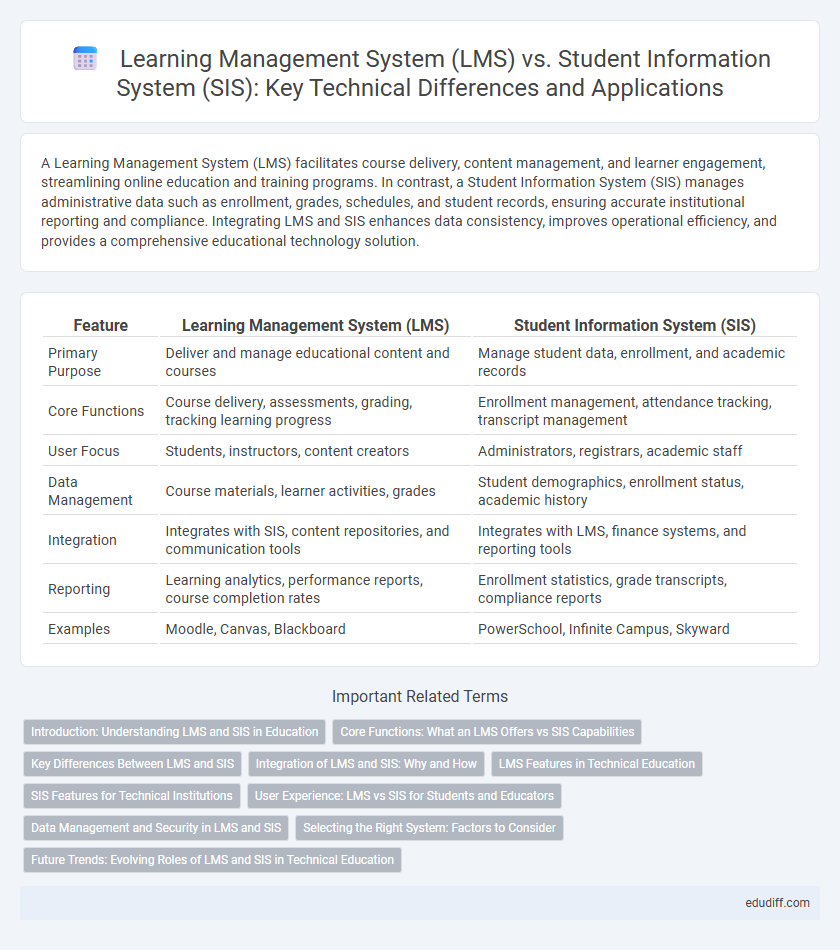A Learning Management System (LMS) facilitates course delivery, content management, and learner engagement, streamlining online education and training programs. In contrast, a Student Information System (SIS) manages administrative data such as enrollment, grades, schedules, and student records, ensuring accurate institutional reporting and compliance. Integrating LMS and SIS enhances data consistency, improves operational efficiency, and provides a comprehensive educational technology solution.
Table of Comparison
| Feature | Learning Management System (LMS) | Student Information System (SIS) |
|---|---|---|
| Primary Purpose | Deliver and manage educational content and courses | Manage student data, enrollment, and academic records |
| Core Functions | Course delivery, assessments, grading, tracking learning progress | Enrollment management, attendance tracking, transcript management |
| User Focus | Students, instructors, content creators | Administrators, registrars, academic staff |
| Data Management | Course materials, learner activities, grades | Student demographics, enrollment status, academic history |
| Integration | Integrates with SIS, content repositories, and communication tools | Integrates with LMS, finance systems, and reporting tools |
| Reporting | Learning analytics, performance reports, course completion rates | Enrollment statistics, grade transcripts, compliance reports |
| Examples | Moodle, Canvas, Blackboard | PowerSchool, Infinite Campus, Skyward |
Introduction: Understanding LMS and SIS in Education
Learning Management Systems (LMS) streamline course delivery, content management, and online assessments, enhancing instructional efficiency in educational institutions. Student Information Systems (SIS) focus on administrative tasks including enrollment, attendance tracking, and grade reporting, providing a centralized database for student records. Integrating LMS and SIS facilitates seamless data exchange, improving both academic management and personalized learning experiences.
Core Functions: What an LMS Offers vs SIS Capabilities
An LMS primarily facilitates course content delivery, student engagement, and progress tracking through features like quizzes, assignments, and multimedia resources. In contrast, an SIS manages student records, enrollment, grades, and administrative data, ensuring compliance with academic policies and reporting standards. While LMS enhances the learning experience, SIS supports institutional operations and data management crucial for academic administration.
Key Differences Between LMS and SIS
Learning Management Systems (LMS) primarily manage and deliver educational content, track student progress, and facilitate online learning environments, while Student Information Systems (SIS) focus on administrative functions such as enrollment, attendance, grades, and student records management. LMS platforms enable course creation, assignment submissions, and interactive learning tools, whereas SIS platforms handle data logistics, reporting, and compliance with institutional policies. Understanding these distinctions clarifies that LMS supports pedagogical processes, whereas SIS ensures efficient management of student data and institutional workflows.
Integration of LMS and SIS: Why and How
Integrating Learning Management Systems (LMS) with Student Information Systems (SIS) enables seamless data synchronization, improving academic record accuracy and reducing administrative workload by automating enrollment, grading, and attendance processes. This integration leverages APIs and middleware solutions to facilitate real-time data exchange, enhancing user experience and supporting data-driven decision-making in educational institutions. Efficient LMS-SIS integration streamlines communication between instructors, students, and administrators, driving operational efficiency and fostering personalized learning environments.
LMS Features in Technical Education
Learning Management Systems (LMS) in technical education offer specialized features such as interactive simulation integration, coding environment support, and real-time skill assessment tools, enhancing practical skill development. These platforms facilitate seamless delivery of multimedia content, adaptive learning paths, and competency-based evaluations tailored to STEM and vocational disciplines. LMS also supports collaboration through discussion forums, peer reviews, and automated grading, streamlining administration and improving learner engagement.
SIS Features for Technical Institutions
Student Information Systems (SIS) for technical institutions prioritize features such as detailed academic records management, course scheduling automation, and real-time grade tracking tailored for engineering and IT programs. Integration capabilities with Laboratory Information Management Systems (LIMS) and competency-based assessments enhance the SIS's functionality in technical education environments. Robust reporting tools and compliance monitoring ensure adherence to accreditation standards and facilitate data-driven decision-making for faculty and administrators.
User Experience: LMS vs SIS for Students and Educators
Learning Management Systems (LMS) provide a user-friendly interface tailored for students and educators to access course materials, submit assignments, and engage in interactive learning activities, enhancing real-time collaboration and feedback. Student Information Systems (SIS) streamline administrative tasks such as enrollment, grade tracking, and attendance management, offering a comprehensive overview of academic records but with limited instructional engagement features. The integration of LMS and SIS improves the overall user experience by combining instructional support with efficient data management, facilitating seamless academic workflows for both students and educators.
Data Management and Security in LMS and SIS
Learning Management Systems (LMS) prioritize secure content delivery and user activity tracking, employing encryption protocols and role-based access controls to safeguard educational materials and learner data. Student Information Systems (SIS) manage comprehensive student records including enrollment, grades, and personal information, implementing stringent data protection measures compliant with FERPA and GDPR regulations. Both systems integrate multi-factor authentication and regular security audits to maintain data integrity and prevent unauthorized access within educational institutions.
Selecting the Right System: Factors to Consider
Selecting the right system requires evaluating key factors such as integration capabilities, data management efficiency, and user accessibility to ensure seamless communication between the LMS and SIS. Prioritize scalability, compliance with educational standards like SCORM and FERPA, and support for analytics to enhance decision-making processes. Cost-effectiveness, customization options, and vendor support quality also play crucial roles in aligning the system with institutional goals and user needs.
Future Trends: Evolving Roles of LMS and SIS in Technical Education
Learning Management Systems (LMS) and Student Information Systems (SIS) are increasingly integrated through AI-driven analytics to offer personalized learning experiences and real-time academic performance tracking. Emerging technologies like blockchain provide enhanced data security and verification within SIS, while LMS platforms adopt immersive tools such as VR and AR to facilitate experiential technical education. The convergence of LMS and SIS functionalities supports adaptive curriculum design and seamless administrative workflows, positioning these systems as pivotal in the future of technical education.
Learning Management System (LMS) vs Student Information System (SIS) Infographic

 edudiff.com
edudiff.com